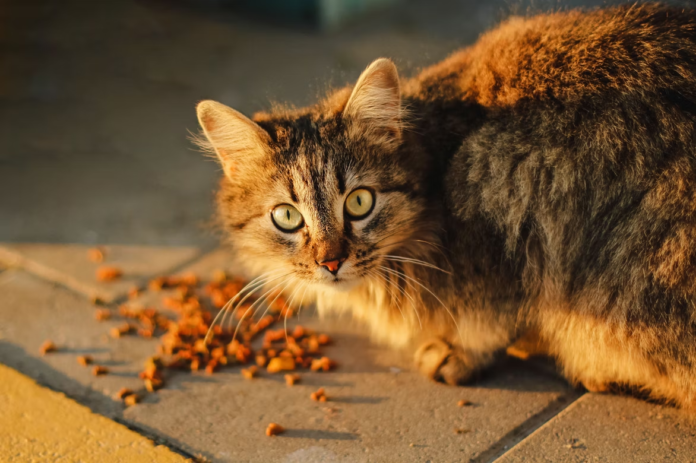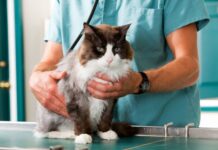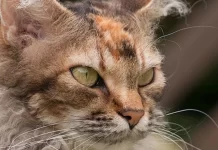Last Updated on January 27, 2024 by Fumipets
Navigating the World of Feline Nutrition: Types of Cat Food and Finding the Right One
Choosing the right type of food for your feline companion is a crucial aspect of responsible cat ownership. With a plethora of options available on the market, each claiming to offer the best nutrition for your cat, navigating the landscape of cat food can be both overwhelming and confusing.
This guide aims to unravel the mystery of feline nutrition, providing insights into different types of cat food and helping you make informed decisions for your beloved pet’s well-being.
Types of Cat Food and Finding the Right One
Cat food is one of the most imperative expenses of feline guardianship, which stands next to veterinary care. However, a proper diet will reduce the vet expenses.
Learning to read the cat labels on cat food becomes essential as it will help you decide and determine the best food for your furry friend.
Cats are omnivorous animals, which means they depend on animal protein to grow and thrive. We will look at the best cat foods available in the market!
Types of Cat Food
Felines do not need carbohydrates to thrive and evolve. Instead, they require dry cat foods like corn, wheat, and rice. Even flavorings are used to make the food better.
Cat or kitten food can be divided into several categories or types. Cat food comes in various consistencies, and each performs distinctly.
Cat food can also be categorized according to the different types.
- Wet Cat Food
Wet Cat food contains high-quality proteins and minerals that provide hydration to the body of the little feline. It is also a good source of various vegetables.
Note that wet cat food is the best food type for cats suffering from a medical illness or recovering from the same.
Wet cat food should not be used as a treat as it can affect your cat’s health. You should treat your cat with wet cat food based on the cat food your cat loves.
- Dry Cat Food
The water content and the dried cat food can be used throughout the day. This food is commonly known as kibble.
It has been noted that dry cat food contains fewer nutrients than wet cat food. But, dry cat food is the best option for daily use.
- Kitten Food
Kittens have a reasonable growth rate, and since it is necessary to provide kittens with all the nutrients possible, here we go. However, kittens cannot bite through all the cat food.
They have problems biting off the dry cat food. Kittens should be given fatty acids in their diet as it helps them to develop quickly and efficiently.
- Complete Cat Food
A balanced diet for a cat would look full of proteins, carbohydrates, taurine, and Vitamin A. These nutrients help maintain the cat’s immune system, eyes, and heart.
It has been scientifically formulated that the cat should be provided with all the required nutrients to facilitate its growth.
- Homemade Cat Food
Based on your discretion, homemade cat food can be any raw meal diet or a cooked meal diet. You will need a source of protein which can include salmon, chicken, etc.
You could even put carbohydrates like rice, barley, and oatmeal in the homemade cat food, fibers like sweet potatoes, and fat such as fish oil, vegetable oil, etc.
How to Find the Right Cat Food?
Feeding a cat is one way by which you can keep your furry friend healthy, happy and active. Markets offer us a wide variety of foods to choose from.
There are a lot of factors that you will have to look at that will determine and help you find the right cat food for your little feline. This is a simple task so dive in!
- Knowing a Cat’s Nutritional Needs
An essential part of choosing the right food for the cat involves choosing the food which contains the best and most nutritious ingredients.
A cat’s diet should contain high-quality proteins, carbohydrates, fatty acids, amino acids, vitamins, and minerals.
The cat’s food should contain Vitamin A, B, C, B12, Folic acid, calcium, magnesium, phosphorus, iron, sodium, and zinc. These nutrients help in the healthy bones of a cat.
- Feed Food According to a Cat’s Life Stage
Many foods state that they are best for cats at any age, but this is not always true. Cats need different kinds of food at every stage of their life. You should know how much dry and wet food to feed your cat for its proper growth and nutrition.
- Kittens
Kittens require food that facilitates their growth, and their diet should include single source proteins like turkey, beef, chicken, lamb, and tuna.
The food you feed to the cat at this stage should be full of nutrients like folic acid, proteins, and fats.
- Adults
Adult cats are less active than the notorious little kittens, and they need less fat and protein.
You can also consider shifting to portion control or timed feeding to prevent your cat from turning obese.
- Senior Cats
A cat is considered a senior cat once it has turned seven. You shouldn’t feed them with proteins or fats in excess as a cat could then turn overweight.
Make sure that a senior cat gets an ample amount of vitamins and minerals and nutrients that will help to boost their immune system.
- Learn About Grains
Whether a cat should eat grains or not is a controversial topic. Grains are excellent sources of carbohydrates that are the building blocks of energy for the feline.
Cats are rarely allergic to grains. Usually, the cats get allergic to protein sources like beef, chicken, or dairy.
Whole grains contain vital nutrients like fatty acids, fiber, vitamins, and minerals. It would be best if you kept an eye out for these whole grains in your cat’s food:
- Brown Rice
- Barley
- Kasha
- Quinoa
- Farro
- Bulgar
These whole grains are very nutritious and beneficial for a cat’s good growth and development.
Conclusion
Cats are obligate omnivorous animals, and they usually require animal proteins to thrive upon. There are different cat foods that one can give to their cats.
Note that cats require different types of nutrition at different stages in their life. A kitten, an adult cat, and a senior cat need different food to develop.
Cats require folic acid, fatty acids, proteins, carbohydrates, taurine, and different vitamins and minerals to thrive. In all, they too need a balanced diet. We hope this article was of help to you!
Questions and Answers on Types of Cat Food
What are the Different Types of Cat Food?
Cat food comes in various forms, including dry kibble, wet or canned food, semi-moist food, and raw or homemade diets. Each type has its pros and cons, and the choice often depends on your cat’s individual needs, preferences, and any specific health considerations.
Is Dry Kibble a Suitable Option for Cats?
Dry kibble is a convenient and cost-effective option, providing a complete and balanced diet for cats. However, some cats may have a preference for wet food, and certain health conditions may warrant a different type of diet. It’s essential to consider factors such as your cat’s age, health status, and personal preferences when opting for dry kibble.
What Makes Wet or Canned Food Beneficial for Cats?
Wet or canned cat food is known for its high moisture content, promoting hydration, which is crucial for urinary health. The soft texture is often preferred by cats, especially those with dental issues. It’s a suitable option for cats who may not drink enough water on their own.
Are Homemade or Raw Diets a Viable Choice for Cats?
Homemade or raw diets involve feeding cats unprocessed foods, such as raw meat and vegetables. While some pet owners opt for this natural approach, it requires meticulous planning to ensure a balanced diet with all essential nutrients. Consulting with a veterinarian is crucial to prevent nutritional imbalances.
How Can I Determine the Right Cat Food for My Pet?
Finding the right cat food involves considering your cat’s age, health condition, activity level, and individual preferences. It’s advisable to choose high-quality cat food with complete and balanced nutrition, and, if needed, consult with a veterinarian for personalized recommendations based on your cat’s specific requirements.


















